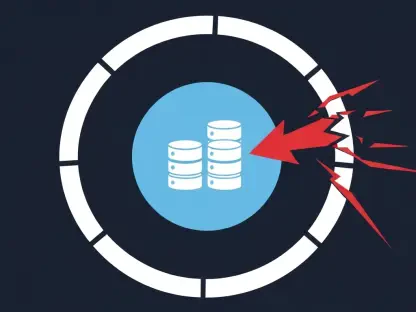What happens when the digital locks safeguarding billions of transactions and personal data become outdated overnight? In today’s hyper-connected world, cryptographic software—the backbone of secure communication—faces relentless threats from advancing technologies like quantum computing, making updates a critical necessity. A single unpatched vulnerability can expose entire systems to catastrophic breaches, yet updating this critical code remains a daunting, often neglected task. This pressing issue of crypto agility, or the ability to swiftly adapt cryptographic implementations, demands attention as cyber risks escalate. Delving into the silent struggles of developers and the high stakes of staying ahead, this exploration uncovers why agility in crypto updates is no longer optional but essential for security.
The Hidden War of Crypto Security
Cryptographic updates are not mere technical chores; they represent a critical battleground for cybersecurity. As hackers exploit weaknesses in outdated encryption, the consequences can ripple across industries, from finance to healthcare, compromising sensitive data on a massive scale. The emergence of quantum computing, with its potential to crack current encryption methods, underscores the urgency of maintaining robust, up-to-date defenses. This silent war often goes unnoticed until a breach makes headlines, revealing how lagging updates can turn trusted systems into liabilities.
The stakes are staggering when considering that nearly 90% of data breaches involve exploited vulnerabilities in software, many tied to outdated cryptographic components. Organizations that fail to prioritize timely updates risk not only financial loss but also irreparable damage to user trust. This reality sets the stage for understanding why crypto agility is a cornerstone of modern security, pushing developers and companies to rethink their approach to software maintenance.
Why Agility Matters in a Threat-Filled World
Crypto agility refers to designing software with the foresight to adapt and replace cryptographic implementations as threats evolve. In an era where cyberattacks grow more sophisticated daily, this proactive mindset is vital to protect against vulnerabilities that could emerge over the next few years, from 2025 to 2027 and beyond. Without such flexibility, systems remain tethered to obsolete protections, inviting risks that could have been mitigated with forward-thinking design.
The looming shadow of quantum computing serves as a stark reminder of the need for agility. Experts predict that within a decade, quantum advancements could render many current encryption algorithms useless, exposing data previously thought secure. For developers and organizations, embedding adaptability into software architecture is not just a best practice—it’s a survival strategy in a landscape where cyber threats evolve faster than ever.
This urgency is compounded by the sheer scale of reliance on cryptographic systems. From securing online banking to protecting government communications, the integrity of these tools underpins global trust in digital infrastructure. Ignoring agility means gambling with security, a risk no entity can afford in today’s volatile environment.
Breaking Down the Barriers to Crypto Updates
Updating cryptographic code presents a maze of challenges that can stump even seasoned developers. A primary obstacle is the widespread lack of specialized knowledge, as many professionals are not trained in the nuances of cryptography, often leading to errors or delays in updates. This gap in expertise creates a bottleneck, slowing down critical security enhancements when time is of the essence.
Another hurdle lies in the heavy dependence on open-source libraries, which, while efficient, can become single points of failure. If these libraries are not regularly maintained, vulnerabilities can affect countless applications, as seen in past incidents where flaws in popular libraries led to widespread exploits. Additionally, disparities in access to information exacerbate the issue—developers in smaller firms often miss crucial updates compared to those in larger organizations with privileged channels for vulnerability disclosures.
The absence of standardized processes further complicates the situation. Many teams handle updates reactively, without clear guidelines, resulting in patchwork fixes that may introduce new risks. Real-world cases, such as delayed patches for known library flaws, highlight how these systemic issues can amplify the impact of cyber threats, leaving systems exposed longer than necessary.
Hearing from the Trenches: Developers Speak Out
Insights from a recent study by the CISPA Helmholtz Center for Information Security, involving interviews with 21 international developers, shed light on the gritty realities of crypto updates. Lead researcher Alexander Krause emphasizes the importance of embedding agility from the design phase, stating, “Planning for future updates at the start can drastically reduce headaches down the line.” This perspective resonates with many in the field who see proactive design as a game-changer, yet struggle to implement it.
Developers often express frustration over the complexity of their task, with one participant admitting, “I felt completely out of my depth trying to update encryption after a vulnerability was flagged on a blog.” Such anecdotes reveal the human toll of this technical challenge, where informal sources like social media or GitHub become lifelines for critical information, often too late to prevent damage. The emotional weight of safeguarding systems against unseen threats is palpable in these accounts.
The study also uncovers a common theme of being overwhelmed by the pace of change in cybersecurity. Developers describe racing against time to patch systems, often without adequate support or training, painting a picture of a workforce stretched thin. These voices from the field underscore the urgent need for better resources and structured approaches to ease the burden of maintaining secure software.
Building a Path to Agile Crypto Solutions
Navigating the chaos of cryptographic updates requires a clear, actionable strategy, and findings from the CISPA study offer a practical roadmap for developers and organizations. A proposed multi-step process begins with defining triggers for updates, such as new threats or obsolescence, ensuring that action is taken before vulnerabilities are exploited. This clarity helps prioritize security in fast-paced development cycles.
Further steps include setting specific goals and assigning roles across internal teams, external contributors, and end users during planning, execution, and rollout phases. Leveraging community resources like GitHub for timely updates, while advocating for improved maintenance of open-source libraries, can mitigate risks tied to outdated code. Additionally, bridging knowledge gaps through targeted training and translating academic research into practical tools are essential to empower developers with the skills needed for success.
These strategies aim to transform crypto updates from a reactive scramble into a systematic process, reducing security risks significantly. By adopting such frameworks, the industry can move toward a future where agility is built into the fabric of software development, ensuring that defenses keep pace with emerging threats. This structured approach offers hope for a more resilient digital ecosystem, grounded in collaboration and preparedness.
Reflecting on the Road Traveled
Looking back, the journey through the challenges of cryptographic updates revealed a landscape fraught with obstacles, from knowledge gaps to inconsistent processes, as developers fought to keep systems secure. The voices of those on the front lines echoed a shared struggle, balanced by a determination to protect users against ever-evolving threats. Each barrier, whether tied to outdated libraries or limited resources, painted a picture of an industry at a critical juncture.
Moving forward, the focus shifted to actionable solutions, embracing structured frameworks to embed agility into software design. Adopting clear triggers for updates and leveraging community platforms emerged as vital steps to fortify defenses. Beyond individual efforts, industry-wide initiatives to enhance training and communication between researchers and practitioners promised to close critical gaps, paving the way for stronger security.
As the digital world continues to evolve, the commitment to crypto agility must remain steadfast. Prioritizing education, refining update processes, and fostering collaboration stand as essential next steps to safeguard data against tomorrow’s risks. This ongoing dedication ensures that the lessons learned become the foundation for a more secure future, where adaptability triumphs over vulnerability.









